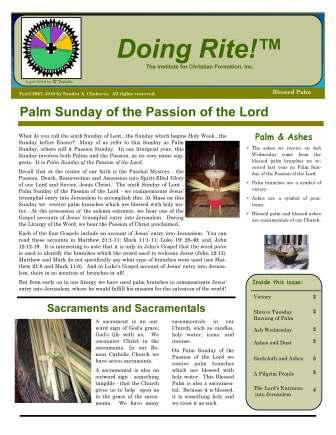The Institute for Christian Formation
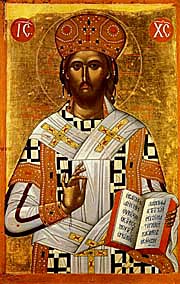
Palm Sunday of the Passion of the Lord
Follow us on Facebook to keep up to date with our news and newest resources!
What do you call the sixth Sunday of Lent...the Sunday which begins Holy Week...the Sunday before Easter? Many of us refer to this Sunday as Palm Sunday, others call it Passion Sunday. In our liturgical year, this Sunday involves both Palms and the Passion, as its very name suggests. It is Palm Sunday of the Passion of the Lord.
At the center of our faith is the Paschal Mystery - the Passion, Death, Resurrection and Ascension into Spirit-filled Glory of our Lord and Savior, Jesus Christ. The sixth Sunday of Lent - Palm Sunday of the Passion of the Lord -we commemorate Jesus’ triumphal entry into Jerusalem to accomplish this. At Mass on this
Entry into Jerusalem
Cretan, 16th Century
We are a pilgrim people on a journey throughout this life, our ultimate destination being heaven. In our Church’s liturgy and in our devotional practices, we are often reminded of this as we physically move from place to place. That is why when we celebrate the Eucharist we come forward to commune in a communion procession. That is why on Palm Sunday of the Passion of the Lord, a procession is the first form listed in the Roman Missal. On Palm Sunday of the Passion of the Lord, we commemorate the Lord’s entrance into Jerusalem where he would take up his cross, die for the salvation of the world, and triumph over death with his resurrection.
The Blessed Palm Branches we receive at the liturgy on Palm Sunday of the Passion of the Lord are taken
into our home and put in a place of honor to be used in prayer. You can even weave your newly received Blessed Palm into traditional religious symbols. (The Italiansrus website has online tutorials for weaving palm into a braid, a cone, a cross, a crown of thorns, and a rose bud.) The book, Catholic Household Blessings and Prayers, has an order of service for “Placing of Branches in the Home.” Perhaps one of the hymns most associated with Palm Sunday is “All Glory, Laud, and Honor.” Download this hymn, and use it in your Palm Sunday prayer and reflection. And here is a link to a Palm Sunday coloring page for children.
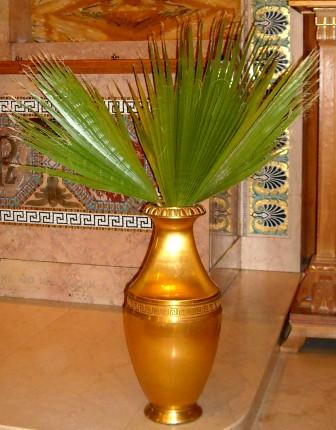
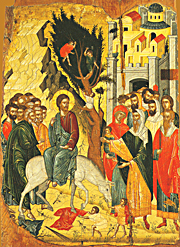
Sunday we receive palm branches which are blessed with holy water. At the procession or the solemn entrance, we hear one of the Gospel accounts of Jesus’ triumphal entry into Jerusalem. During the Liturgy of the Word, we hear the Passion of Christ proclaimed.
Each of the four Gospels includes an account of Jesus’ entry into Jerusalem. You can read these accounts in Matthew 21:1-11; Mark 11:1-11; Luke 19: 28-40; and, John 12:12-19. It is interesting to note that it is only in John’s Gospel that the word palm is used to identify the branches which the crowd used to welcome Jesus (John 12:13). Matthew and Mark do not specifically say what type of branches was used (see Matthew 21:8 and Mark 11:8). And in Luke’s Gospel account of Jesus’ entry into Jerusalem, there in no mention of branches at all!
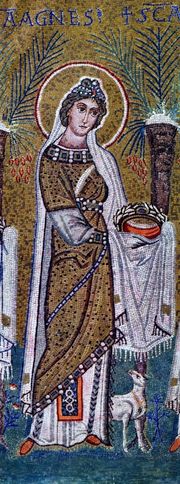
Saint Agnes (Mosaic)
Byzantine Heritage, circa 450
Galla Placidia Mausoleum, Italy
But from early on in our liturgy we have used palm branches to commemorate Jesus’ entry into Jerusalem, where he would fulfill his mission for the salvation of the world!
Palm branches have made their way into much of our religious art, especially in the Western Church. For example, you will often see holy cards or paintings of the Saints that include palm. And this has been true for a long time, as you can see in this 5th century mosaic of Saint Agnes. What is so special about palm? Palm signifies victory!
In ancient Israel, palm branches were carried by those who were victorious in conquering enemies (1 Maccabees 13:51). And by his death and resurrection, Jesus conquered the greatest enemy, death! That is why you will often see paintings of the resurrected Jesus holding palm branches. In art, the Saints are often pictured with palm branches because of their own victory. Recall that in the Book of Revelation, the elect in heaven are holding palm branches, indicating their own triumph in remaining faithful to Jesus in the time of great persecution, even though it cost them their earthly life (Rev. 7:9).
The Israelites also used palm branches in the celebration of the Feast of Booths (Leviticus 23:39-40), and in the Purification of the Temple (2 Maccabees 10:5-8). As Judeo-Christians, palm has been an important part of our religious heritage for centuries!
Click on image above to download our ICF bulletin, "Palm Sunday of the Passion of the Lord."
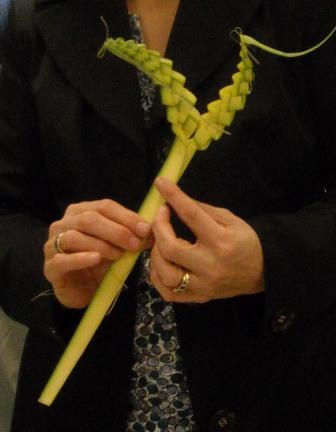
Hosanna to the Son of David!
